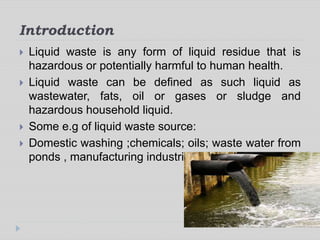6 Easy Facts About Reclaim Waste Described
6 Easy Facts About Reclaim Waste Described
Blog Article
Reclaim Waste Fundamentals Explained
Table of ContentsNot known Factual Statements About Reclaim Waste Little Known Questions About Reclaim Waste.The smart Trick of Reclaim Waste That Nobody is Talking AboutUnknown Facts About Reclaim WasteThe Single Strategy To Use For Reclaim Waste
Discover the types, events, and types of liquid waste. Residential sewage waste refers to the waste and items from a residential septic system. This type of waste is developed by people in residences, institutions, and other buildings. This only consists of sewage-disposal tanks that have a drainpipe field. The correct administration and disposal of domestic sewer waste need liquid waste to be moved to a sewage treatment plant where the appropriate methods and tools are related to detoxify and deal with waste.
Commercial waste commonly includes potential risks, such as combustible materials or a blend of liquid and strong waste products, and requires a much more advanced and in-depth disposal procedure. The disposal of industrial waste usually entails the purification of waste prior to transport to ensure risk-free and correct disposal. Industrial waste is created from results and overflow of industrial processes and production.
This type of waste can not make use of the very same sewer monitoring transport or procedures as septic or industrial liquids. The industrial waste administration procedure calls for the inspection and screening of fluid waste before it undergoes the disposal process (liquid waste disposal). Drainage waste is the fluid waste that originates from drainage and excess stormwater in very populated areas or cities
Drainage waste can trigger contamination and flooding if not dealt with correctly. Guaranteeing correct waste monitoring can avoid disasters and minimize environmental harm.
Reclaim Waste Fundamentals Explained
Contact PROS Solutions today to discover our waste management and disposal solutions and the proper means to care for the fluid waste you create.
(https://reclaimwaste1.bandcamp.com/album/reclaim-waste)Do you know what occurs to your water when you end, purge the commode or drain the cleaning maker? No? Well, it's worth recognizing. This so-called 'wastewater' is not only an essential resource yet, after therapy, will be launched to our land, waterways or the ocean. Made use of water from bathrooms, showers, baths, kitchen sinks, laundries and industrial procedures is referred to as wastewater.

water made use of to cool down machinery or tidy plant and tools). Stormwater, a kind of wastewater, is overflow that flows from farming and city areas such as roofs, parks, gardens, roadways, courses and gutters right into stormwater drains pipes, after rain. Stormwater streams untreated directly to neighborhood creeks or rivers, eventually reaching the sea.
Some Known Details About Reclaim Waste
In Queensland, many wastewater is dealt with at sewage therapy plants. Wastewater is transported from domestic or industrial websites with a system of sewage systems and pump stations, understood as sewage reticulation, to a sewage treatment plant. City governments develop, keep and run most sewage therapy plants. Operators are licensed under the Environmental Management Act 1994 to discharge cured wastewater at an acceptable environmental requirement into waterways.
The Department of Natural Resources advises neighborhood federal governments concerning managing, operating and maintaining sewage systems and therapy plants. In unsewered areas, city governments might need householders to install specific or family sewage treatment systems to treat residential wastewater from commodes, cooking areas, washrooms and washings. The Department of Natural Resources authorizes making use of household systems when they are proven to be reliable.
Many stormwater receives no therapy. In some new subdivisions, therapy of some stormwater to eliminate litter, sand and crushed rock has started using gross toxin traps. Wastewater treatment takes place in 4 phases: Gets rid of strong matter. Bigger solids, such as plastics and other things incorrectly released to drains, are removed when wastewater is travelled through screens.
Wastewater after that flows right into large storage tanks where solids settle and are eliminated as sludge. Oil and scum are skimmed from the surface area. Utilizes little living organisms called micro-organisms to damage down and get rid of remaining dissolved wastes and great fragments. Micro-organisms and wastes are incorporated in the sludge. Eliminates nitrogen and phosphorus nutrients that can cause algal flowers in our waterways and endanger water life.
Things about Reclaim Waste
Nutrient removal is not read review available in any way sewer therapy plants because it requires expensive specialised tools. It is becoming more common in Queensland. Clear fluid effluent generated after treatment might still have disease-causing micro-organisms. If this effluent is released right into rivers such as rivers or the sea, the micro-organisms will at some point pass away out.

This generally implies wastewater needs to be dealt with or pollutants removed prior to it can be discharged to waterways. The majority of wastewater streams into the sewage system. Under the Act, regional federal governments provide approvals and permits for ecologically relevant activities (ERAs) entailing wastewater releases that could have a regional impact. The division administers authorizations and permits to ERAs entailing wastewater releases that may have a regional or statewide influence.
The Ultimate Guide To Reclaim Waste
Tracking supplies accurate info regarding water high quality and can verify that permit conditions are being satisfied. The info acquired with monitoring gives the basis for making water top quality choices.
Report this page